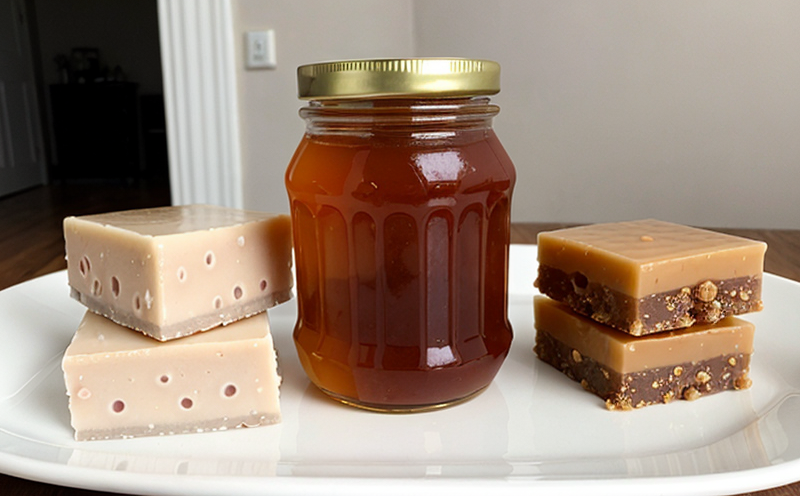ASTM E1871 Moisture Determination in Honey
The testing of moisture content in honey is a critical process that ensures product quality and meets regulatory standards. ASTM E1871 specifies the method for determining the moisture content of honey by gravimetric analysis. This standard is essential for food safety, ensuring that the product remains within acceptable limits to prevent spoilage and maintain its natural properties.
The significance of this test cannot be overstated in the food & feed sector, particularly for confectionery products which often incorporate honey as a key ingredient. Proper moisture content plays a crucial role in preserving the texture, flavor, and nutritional value of these items. Excess or insufficient moisture can lead to mold growth, crystallization, or even legal repercussions due to non-compliance with international standards.
The ASTM E1871 method is designed to be precise and reliable, offering reproducibility that is vital for quality control in manufacturing processes. This standard ensures consistency across batches of honey, which is particularly important for producers who rely on honey as a key ingredient in their confectionery items. Compliance with this standard also helps manufacturers avoid potential recalls or product withdrawals due to microbial contamination.
For R&D engineers and quality managers, understanding the ASTM E1871 method is crucial because it directly impacts the formulation of new products and the optimization of existing processes. By adhering to this standard, they can ensure that their products meet not only legal requirements but also consumer expectations regarding taste and texture.
The gravimetric analysis used in ASTM E1871 involves drying a sample at a specific temperature (105°C ± 2°C) until it reaches constant weight. The difference between the initial mass of the honey sample and its final dried weight provides an accurate measure of the moisture content. This method is preferred for its simplicity and accuracy, making it a widely accepted technique in both laboratory settings and industrial applications.
The importance of this test extends beyond just compliance; it also aids in optimizing production processes to ensure consistency in product quality. By closely monitoring moisture levels using ASTM E1871, producers can make informed decisions about ingredient ratios and storage conditions, thereby enhancing overall product performance. This is particularly important for confectionery products that rely heavily on honey as a sweetener.
In conclusion, the ASTM E1871 method is an indispensable tool in the food & feed industry, especially when it comes to testing moisture content in honey. Its precision and reliability make it a cornerstone of quality assurance programs across various sectors, ensuring not only regulatory compliance but also consumer satisfaction.
Why It Matters
The accurate determination of moisture content in honey is vital for several reasons, including food safety, product quality, and regulatory compliance. Ensuring the right amount of moisture prevents spoilage, mold growth, and other quality issues that can arise from excessive or insufficient water content.
- Food Safety: Excess moisture can lead to microbial growth, which poses a significant health risk if consumed. By adhering to ASTM E1871, manufacturers ensure that their products meet the highest safety standards.
- Quality Control: Maintaining consistent moisture levels is essential for preserving the texture and flavor of honey-based confectionery items. Variations in moisture content can lead to undesirable changes in product quality.
- Regulatory Compliance: Many countries have specific regulations regarding the moisture content of honey, ensuring that products meet these standards helps avoid legal issues and potential recalls.
In addition to these benefits, accurate moisture determination also supports better ingredient management and efficient production processes. By using ASTM E1871, manufacturers can optimize their operations, reducing waste and improving overall efficiency.
Benefits
- Increased Product Quality: Ensuring that honey has the right moisture content enhances its sensory attributes, such as texture and flavor. This leads to a better overall product experience for consumers.
- Better Shelf Life: Proper moisture management extends the shelf life of honey-based products by preventing spoilage due to excess moisture or mold growth.
- Enhanced Compliance: Adhering to ASTM E1871 ensures that producers meet international standards, thereby avoiding legal issues and maintaining a good reputation in the market.
- Improved Ingredient Management: Accurate moisture determination helps in optimizing ingredient ratios, leading to more efficient use of resources and reduced waste.
The precision offered by ASTM E1871 allows for better decision-making regarding storage conditions and processing methods. This not only improves product quality but also contributes positively to the overall efficiency of production processes.
Environmental and Sustainability Contributions
- Resource Efficiency: By ensuring optimal moisture content, honey producers can reduce waste and enhance resource utilization. This contributes significantly to sustainable practices in the food & feed sector.
- Reduced Spoilage: Proper moisture management helps minimize the amount of spoiled products, which in turn reduces environmental impact by preventing unnecessary disposal.
The use of ASTM E1871 not only benefits producers but also contributes to broader sustainability goals. It promotes a circular economy model where resources are used efficiently and waste is minimized. This aligns with global efforts towards more sustainable food production practices.





